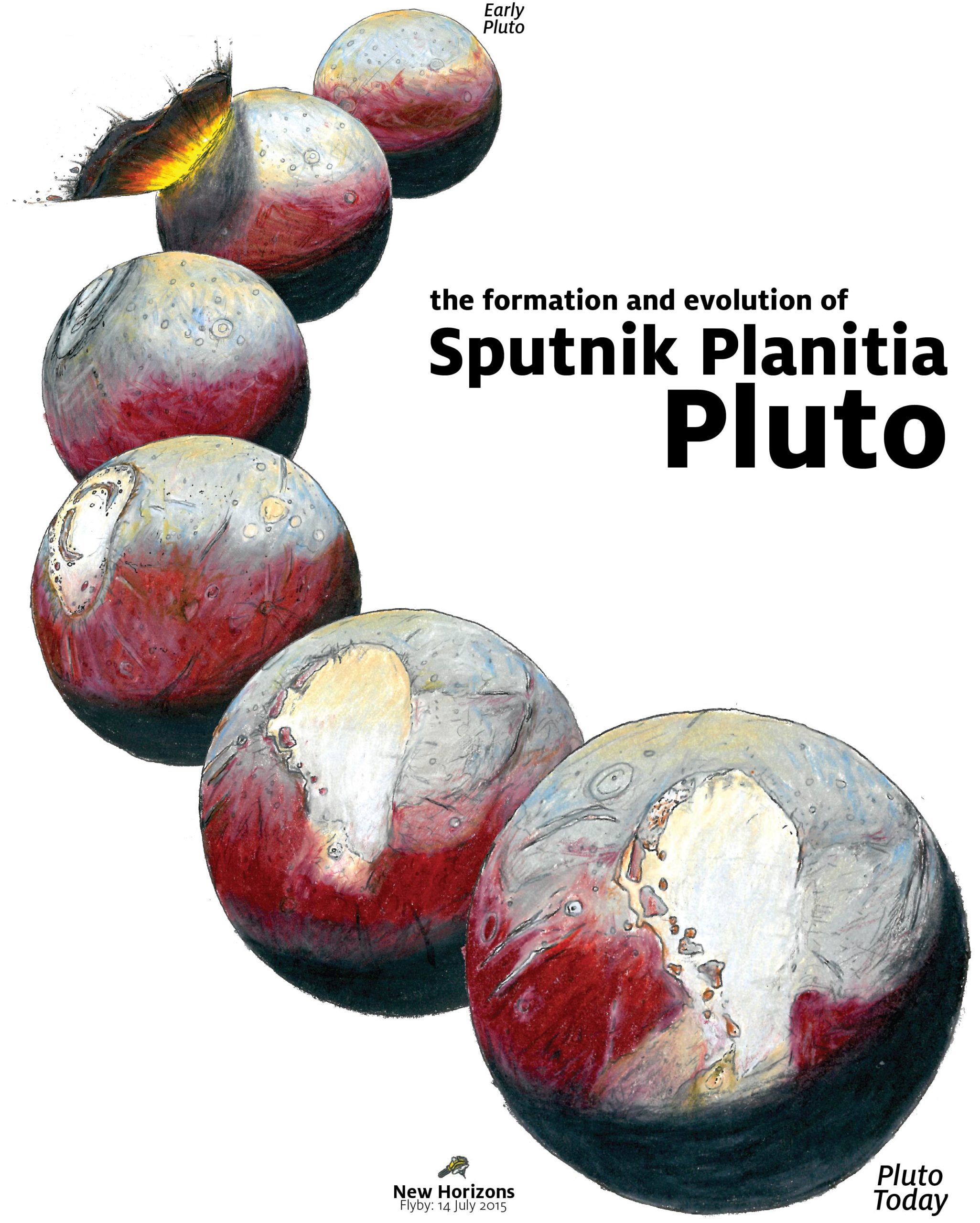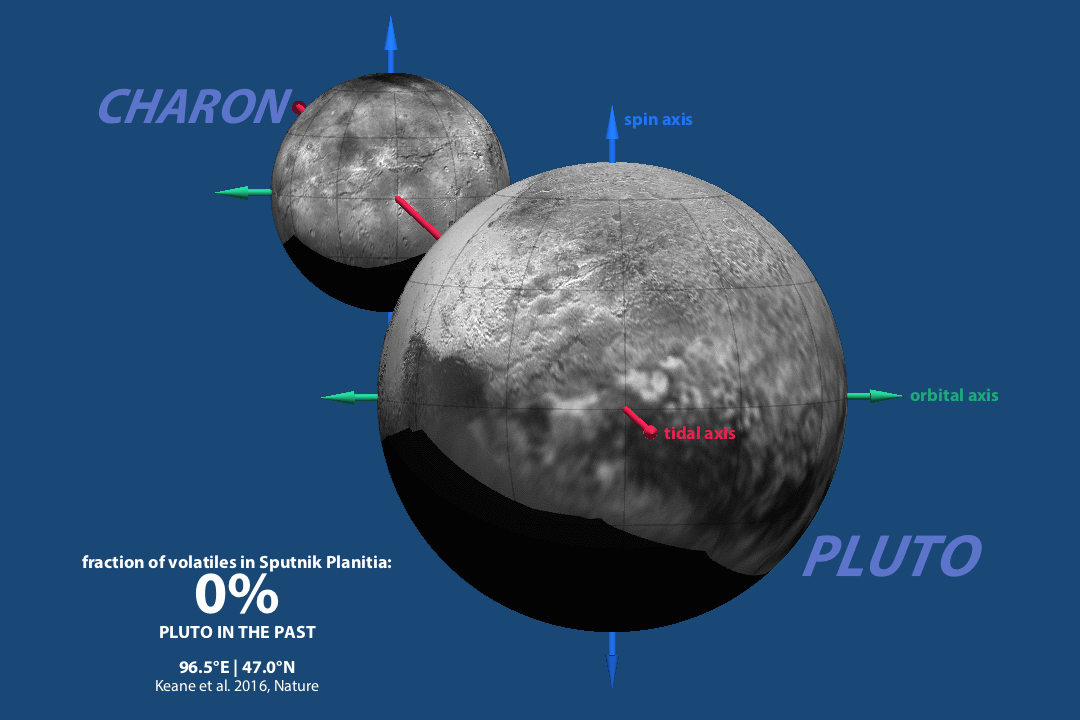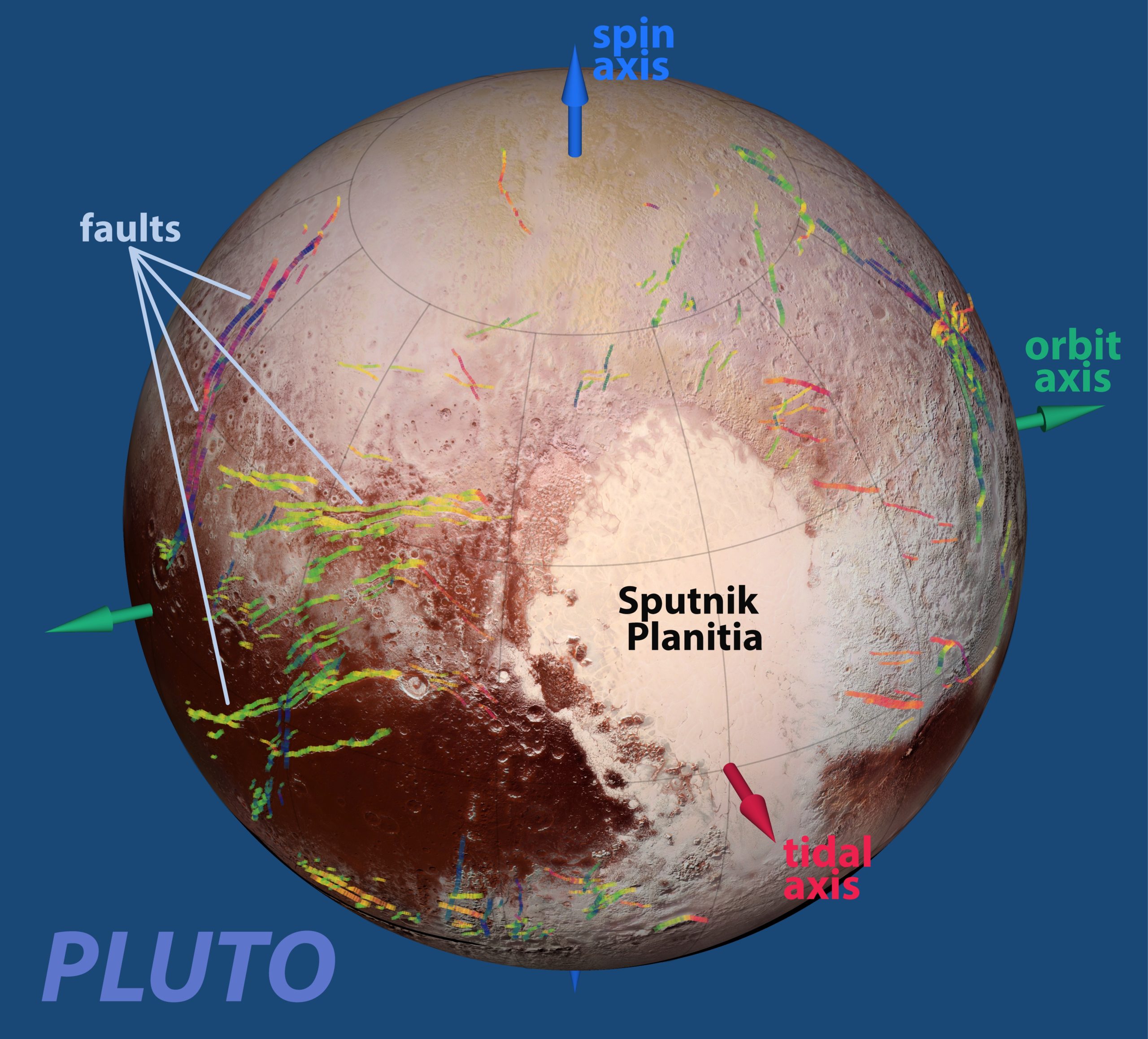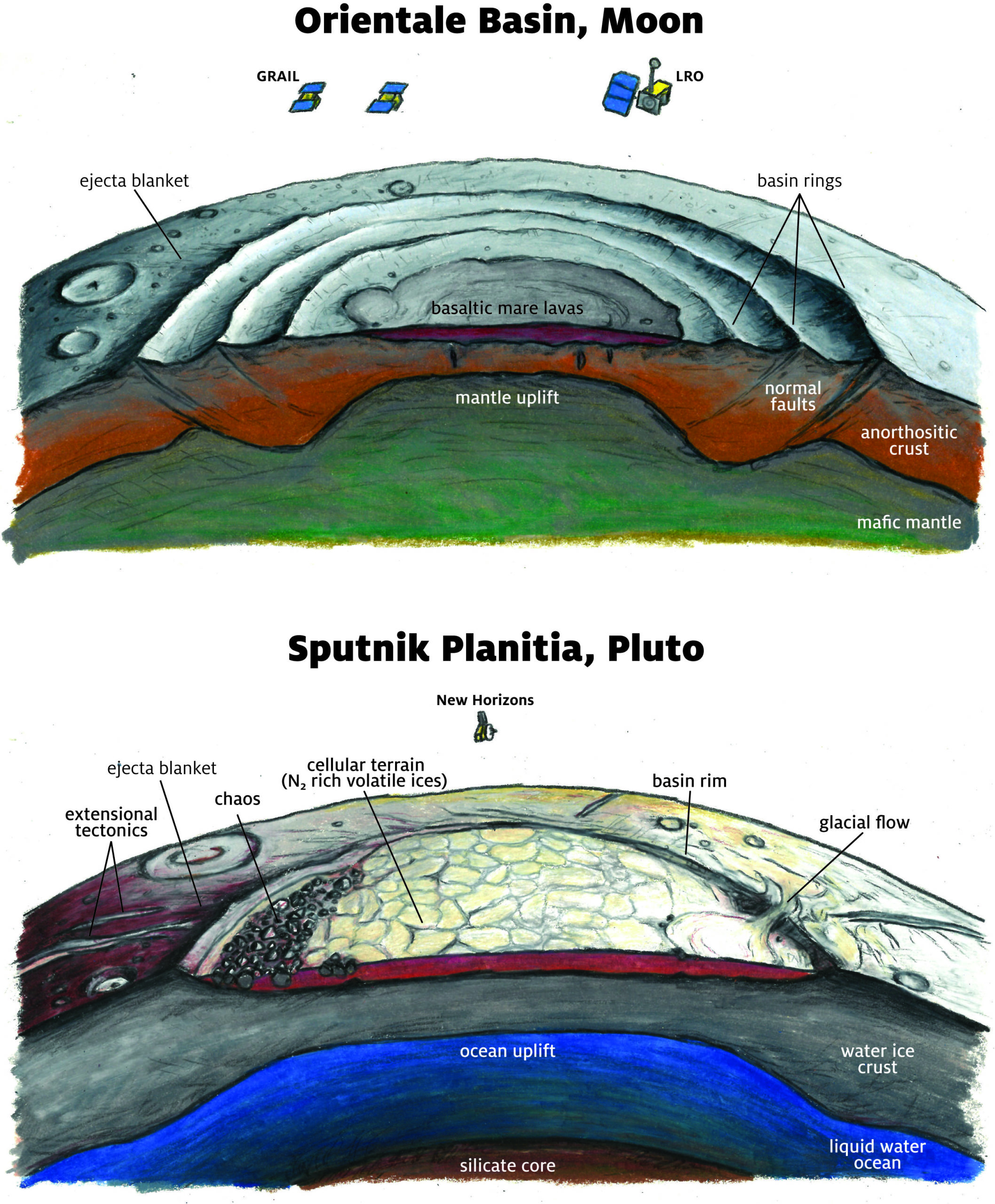Four billion years ago, an asteroid the size of Manhattan smacked into Pluto, punching out a crater that filled up with ice from above and water from below, eventually becoming so heavy it caused the entire planet to tip over.
A view of Pluto centred around the icy, crater-free surface known as Sputnik Planitia. Image: NASA/New Horizons
That, at least, is the conclusion of two new scientific papers published today in the journal Nature. Each paper seeks to explain how Sputnik Planitia — the brilliant, ice filled basin affectionately called the “left lobe” of Pluto’s heart — formed and evolved over time. Together, the two studies tell a remarkable, almost fantastical origin story involving giant asteroids, buried oceans and exotic ices that twisted entire worlds upside down in aeons past.
While the papers agree on the broad brushstrokes and diverge on the details of how Sputnik Planitia came to be, neither analysis is complete or irrefutable. The truth about Pluto’s icy heart possibly lies somewhere in the middle.

A 1050km-wide, teardrop-shaped basin that is believed to have formed during an ancient impact, Sputnik Planitia has received more attention than any other geologic feature spotted on Pluto during the New Horizons flyby. And for good reason: Pluto’s shiny left lobe is downright astonishing. Flat, smooth and brilliant, this vast, icy plain features virtually no craters, suggesting the surface has been renewing itself since it was formed. In other words, Pluto is geologically active.
But while Sputnik Planitia revealed things about the former ninth planet we never expected to learn, its location, at Pluto’s equator, posed a mystery.
“If you drew a line from the center of Charon through Pluto, it would come out on the far side right near Sputnik Planitia,” said James Keane, a doctoral student at the University of Arizona’s Lunar and Planetary Laboratory. “That line is called the tidal axis. Anytime in planetary science that we see a connection between a large geologic feature and this special axes, it’s basically a hallmark of a process called true polar wander.”
True polar wander, or the re-orientation of a planet with respect to its axis of rotation, occurs because planets, like all other objects, prefer to spin in the way that minimises energy. If you stuck a wad of gum on a toy top, it would cause the top to tip over until it reached a new, minimum energy spin axis. Likewise, if you add a bunch of mass to a planet’s north pole, the extra weight will tug that pole toward the equator.
We see evidence of true polar wander all over the solar system. On Mars, a vast mountain belt — something planetary scientists call a “positive mass anomaly” — sits squarely on the equator. On Saturn’s moon Enceladus, a chain of geysers are spewing seawater into space, producing a negative mass anomaly that happens to lie right at the south pole. In both cases, when weight was added or subtracted, the celestial body reoriented to compensate.
Sputnik Planitia’s equatorial location suggests the basin is heavy — so heavy it caused the entire planet to tip over. “The assumption is that it’s a positive mass anomaly,” Keane said.
But this is all rather odd, because remember, Sputnik Planitia formed when a rogue space rock smacked into Pluto, a collision which probably ejected a lot of mass out of the basin. Something must have happened since then to add a lot of weight back — but what?

Animation showing how Pluto might have re-oriented itself in response to volatile ices accumulating in Sputnik Planitia. Image: James Tuttle Keane. Maps of Pluto and Charon by NASA/Johns Hopkins University Applied Physics Laboratory/Southwest Research Institute.
That’s where the new studies comes in. Keane’s analysis, which used computer simulations to imagine where Sputnik Planitia formed and how it migrated over time, indicates that an accumulation of volatile ices, namely nitrogen, methane and carbon monoxide, has made Pluto’s heart heavy.
“Pluto has really extreme seasons, and volatile ices migrate around the surface on seasonal timescales,” Keane explained, adding that topographic depressions like Sputnik Planitia are cold traps, encouraging ices to settle out. “Our idea is that this basin formed up north, some fifty to sixty degrees away from its present location, and as each season went by, more ice got trapped, causing the basin to reorient toward the equator.”
Keane’s models indicate that Sputnik Planitia has accumulated a lot of volatiles, enough to yield a several-kilometre thick sheet of ice. Fault networks on Pluto’s surface support the idea that this icy mantle has been migrating in a southeasterly direction over time, tugging the rest of the dwarf planet along with it.
Still, Keane admits, it is hard to image a scenario in which ice alone caused Pluto to tip over. “You’d need many tens or hundreds of kilometers of it,” he said.

Pluto, with annotated fault scars that provide evidence of true polar wander. Image:James Tuttle Keane
Francis Nimmo, a planetary scientist at UC Santa Cruz who led the other study out today in Nature, has a slightly different take on Sputnik Planitia that may solve this problem. Whereas Keane’s study focuses on the power of ice, Nimmo’s model simulations indicate that a slushy, subsurface ocean did most of the heavy lifting that caused Pluto to roll over.
Planetary scientists have long suspected that at some point, Pluto had a deeply buried, liquid water ocean, kept warm by the heat of radioactive elements in the dwarf planet’s core. According to Nimmo’s analysis, after Sputnik Planitia was carved out, the topographic depression would have started to rebound, drawing water up from this underground reservoir.
“If you remove a big chunk of ice from the surface, you’re removing a lot of overburden,” Nimmo explained. “What happens then is that water underneath pushes up on the remaining ice, and rises up. And because water is denser than ice, that gives you some extra mass.”

Comparison of mantle uplift in the Moon’s Orientale Basin with proposed ocean uplift in Sputnik Planitia. Image: James Tuttle Keane
Nimmo estimates that Sputnik Planitia’s slushy ocean is up to 100km deep, and buried beneath another 200km of ice. The ocean is probably filled with ammonia salts, he said, which not only act as antifreeze, they increase the density of the water, making Pluto’s heart even heaver.

Both researchers were quick to point out that their hypotheses are not mutually exclusive, and that in fact, a combination of ice and water were probably responsible for Pluto’s big stumble. “Both of us agree that this reorientation happened, and that Sputnik Planitia has extra mass,” Nimmo said.
“Like all things in science, it’s probably a little bit of both,” Keane added. “Volatiles, oceans, and things we haven’t explored in detail.”
Unfortunately, the best way to confirm Keane and Nimmo’s theories is through detailed gravity measurements, and to get those, we’re going to need to stick a probe in orbit around Pluto. Given that such a mission is not even on the drawing board yet, it’s safe to say we’re going to be pondering the origin of Pluto’s heart for a long time.
Meanwhile, New Horizons continues to sail away from the Sun, and is on track to rendezvous with a mysterious red Kuiper Belt Object, MU69, in 2019. No doubt, the spacecraft’s second flyby will uncover more wonders and continue to upend everything we thought we knew about the outer solar system.
